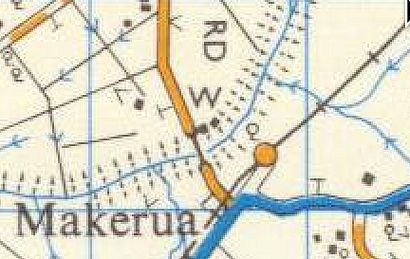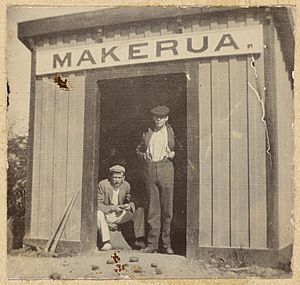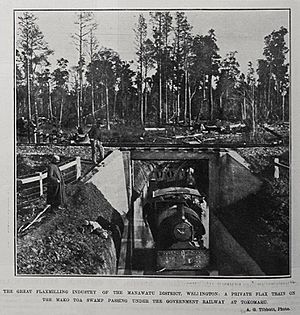Makerua railway station facts for kids
Quick facts for kids
Makerua railway station
|
|||||||||||
|---|---|---|---|---|---|---|---|---|---|---|---|

1961 one inch map
|
|||||||||||
| Location | New Zealand | ||||||||||
| Coordinates | 40°30′46″S 175°27′13″E / 40.512653°S 175.453649°E | ||||||||||
| Elevation | 8 m (26 ft) | ||||||||||
| Line(s) | North Island Main Trunk | ||||||||||
| Distance | Wellington 111.32 km (69.17 mi) | ||||||||||
| History | |||||||||||
| Opened | 2 August 1886 | ||||||||||
| Closed | 23 October 1966 | ||||||||||
| Services | |||||||||||
|
|||||||||||
Makerua railway station was once a busy train stop in the Horowhenua District of New Zealand. It was part of the important North Island Main Trunk railway line. Today, only a single train track runs through the spot where the station used to be.
Contents
The Station's Early Days
Makerua station first opened on Monday, August 2, 1886. It was a "flag station," which meant trains would only stop there if someone waved a flag to get on, or if a passenger on the train asked to get off.
The Wellington and Manawatu Railway Company built and operated this line. Trains started running between Longburn and Ōtaki on the opening day. A special train had even run earlier, in April 1886, to Ohau.
The very first train that went all the way from Wellington to Palmerston North passed through Makerua on November 30, 1886. Even though it was open, Makerua station didn't show up in train timetables until 1888. By 1910, trains traveling from Palmerston North to Wellington began stopping regularly at the station.
Growing the Station
Over the years, Makerua station got some upgrades. In 1889, a new siding was added. A siding is a short track next to the main line where trains can wait or be loaded. A new platform was also built, making it easier for people to get on and off trains.
By 1911, the station had a shelter shed, which was a small building to protect passengers from the weather. It also had a loop line that could hold 16 wagons. A loop line allows trains to pass each other or turn around.
From 1929, a special system called a "tablet" was used. This was a safety device that made sure only one train could be on a certain section of track at a time. A completely new station building was constructed in 1946.
Life Around Makerua
To the northwest of the railway line was the Makerua Swamp. This area was important for local industries. By 1903, about 11 miles (18 km) of tramway tracks had been laid in the swamp. These small railways were used to carry goods, especially from the many flax mills in the area. Flax was a valuable plant used to make ropes and other products.
Facing the Wind
The area around Makerua could be quite windy. In both 1916 and 1936, strong winds were powerful enough to blow trains off the tracks at Makerua. During the 1936 storm, the station's shelter shed was also blown over. To help with this problem, a device called an anemometer was installed at nearby Shannon in 1937. This device checks wind speeds to help keep trains safe.
Station Closure
Makerua railway station eventually closed its doors to all train traffic on October 23, 1966.



